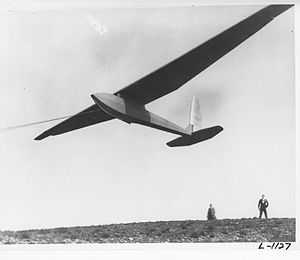Bowlus SP-1 Paper Wing
| SP-1 Paper Wing | |
|---|---|
 | |
| Anne Morrow Lindbergh flying the Bowlus SP-1 Paper Wing on launch | |
| Role | Glider |
| National origin | United States |
| Designer | William Hawley Bowlus |
| First flight | 1929 |
| Status | Sole example no longer exists |
| Number built | One |
|
| |
The Bowlus SP-1 Paper Wing was an American parasol-wing, single-seat, glider that was designed and constructed by William Hawley Bowlus, first flying in 1929.[1]
Design and development
The SP-1 was named the "Paper Wing" because its wing rib webs were fabricated from paper. Otherwise the aircraft was predominantly wood and doped aircraft fabric.[1]
The aircraft originally had 44 ft (13.4 m) span wing with a USA 35-A airfoil. The wingspan was later increased to 47 ft (14.3 m), mostly by increasing the size of the ailerons. The aircraft achieved a very low empty weight for its size of 160 lb (72.6 kg) and a matching low wing loading as well.[1][2]
Operational history

The SP-1 was the first American-built glider to fly for over an hour.[1] The SP-1 was flown by both Charles Lindbergh and Anne Morrow Lindbergh.
Variants
A copy of the SP-1, called the Nighthawk, was flown by William A. Cocke to a world endurance record of 21:34 in 1931. This glider is in the Museum of Flying in Santa Monica, California.[1]
Aircraft on display
- San Diego Air & Space Museum - SP-1 replica[1][3]
- Museum of Flying - Nighthawk[1]
Specifications (SP-1)
Data from Sailplane Directory[1]
General characteristics
- Crew: one
- Wingspan: 44 ft (13 m)
- Wing area: 179 sq ft (16.6 m2)
- Aspect ratio: 11:1
- Empty weight: 160 lb (73 kg)
- Gross weight: 305 lb (138 kg)
Performance
- Maximum glide ratio: 20:1
- Wing loading: 1.7 lb/sq ft (8.3 kg/m2)
See also
- Related lists
References
| Wikimedia Commons has media related to Bowlus SP-1 Paper Wing. |
- ↑ 1.0 1.1 1.2 1.3 1.4 1.5 1.6 1.7 Activate Media (2006). "Paper Wing SP-1 Bowlus". Retrieved 9 August 2011.
- ↑ Lednicer, David (2010). "The Incomplete Guide to Airfoil Usage". Retrieved 1 August 2011.
- ↑ San Diego Air & Space Museum (2011). "Museum Map". Retrieved 1 July 2011.
| ||||||||||
| ||||||||||||||||||||||